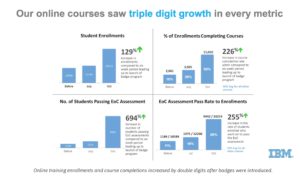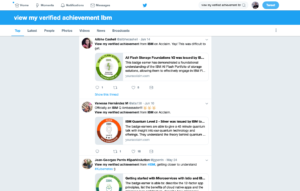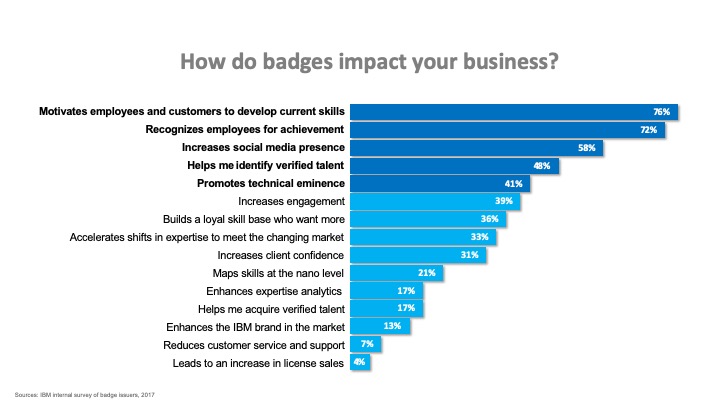When the Open Badges standard was established in 2012, the mission was straightforward: Create a method for packaging information about accomplishments and embed it into portable image files as digital badges. The use cases were thin and value to business was unknown. But when IBM jumped in and decided to develop its own digital badge program, the value to corporations began to emerge.
As a senior executive at IBM in the summer of 2014, we began to explore the value of digital badges for a single use case: How can we increase the engagement of software developers who use our data products? We had launched a successful online learning platform called “Big Data University,” now called Cognitive Class, where we hosted valuable free training developed by our top developers and data scientists. The site was receiving good traffic, but the engagement was lagging: Students were not completing courses and taking the final exams. What if we introduced digital badges as an incentive to encourage engagement?
Early success for the IBM Digital Badge Pilot began with online learning
The IBM Digital Badge Program began in earnest during the early months of 2015 and was ready to launch as a pilot for online learning by spring. Within weeks, we began to see dramatic results. Student enrollments increased by 129% and the percentage of enrollees who actually completed courses increased by 226%. The number of students passing the end of course exam increased by 694% compared to the six-week period leading up to the introduction of digital badges. It’s important to note there were no other contributing factors to this success, like promotions or announcements from IBM executives.

The success of the pilot launched a dramatic expansion of the digital badge program at IBM. The program now issues badges for employees, clients, students and partners. We have issued nearly two million digital badges in all 195 countries. Every division in the organization issues digital badges and is capturing value from the program. We’ve implemented surveys and analyzed the data to find out how:
Increased engagement
IBM’s human resources department found a correlation between badges and engagement. Employees who earn digital badges show higher engagement scores than employees who do not. Among IBM badge recipients, 87% said they are more engaged because of the digital badge program. A full 72% of IBM managers now employ badges to recognize employees for achievement.
Increased sales
IBM found a correlation between sales and digital badges. Technical sales professionals who have earned digital badges are more likely to achieve sales quotas than employees who have not earned badges. These studies show correlation and more work can be done to determine causation. Digital badges can also create leads for products. When digital badges were introduced to an online training site with links to product downloads, those downloads increased by 64%, showing training (with incentives to complete the activities) can actually create leads for products.
“87% of IBM badge earners say they are more engaged because of the digital badge program.”
Increased skills for the company
A survey of IBM business units found 76% said digital badges motivates employees and customers to develop current skills. One third said digital badges accelerate shifts in expertise to meet the changing market.
Single skills registry
IBM’s digital badge program has created a collective skills registry. At any given hour of any given day, chances are there is a skills building activity in progress in the IBM ecosystem. But most of these activities employ disparate student registration systems, from learning management systems to simple spreadsheets which sit on a notebook computer. But when the activity issues digital badges, all of these achievements are captured and catalogued in a single “badge wallet system” in a standard format with embedded information about the activity.
Expertise location and staffing
IBM uses a variety of sophisticated tools and programs to identify expertise in the organization. Because digital badges are embedded with specific information about an achievement, IBM’s systems can quickly identify expertise at the granular level, including specific skills, relevance and date of achievement. That information allows IBM to match and deploy the right people to solve business problems for its clients and its own business. IBM has incorporated digital badges into many systems, including its learning platforms and company directories. That integration improves project staffing, employee development, incentive programs and resource mapping.
Skills gaps
Readiness in an era where technology is changing quickly presents a challenge to any organization. IBM’s business spans the globe and touches nearly every industry on earth. These challenges require a deep understanding of the skills needed to provide business value. It also requires a tool to understand gaps and readiness. Because IBM’s badge program generates a consolidated skills registry in all 195 countries which includes its employees, partners and clients, the company can use its analytics tools, like the Cognos portfolio, to identify skills readiness and then create programs to fill gaps. For example, if the company releases a new product in a geography, a business unit can run a report to determine how many skilled individuals are in the area, what skills are missing and what activities should be delivered to create success. The metadata embedded into each badge is machine readable and can be used for many applications.
Social media presence
When you earn a digital badge, you have the opportunity to share it easily and instantly on social media, increasing your eminence and building trust. When a badge earner shares a digital badge, the badge shows up in a social media activity stream. If you search Twitter, for example, and type “View my verified achievement IBM,” your activity stream will populate with badges from the latest earners. Thousands of IBM digital badges trickle in to activity streams all day long. Even at a fraction of a cent per impression, the IBM Digital Badge Program generates tens of thousands of dollars’ worth of earned media every week of the year.

Digital badges create digital resumes
A full 92% of survey respondents said IBM digital badges improve their employability. Digital badges use a “badge wallet” or “backpack” system. The backpack system aggregates a person’s digital credentials from a variety of issuers to create a digital resume. Badge issuers can decide whether they want to make that information publicly available, and they can easily share a web link with an employer or client. Because of their transparency and the data which is embedded by the issuer, digital badges provide verifiable, trusted achievements, which contrasts with the self-assertions many professionals promote on sites like LinkedIn.
“92% of survey respondents said IBM digital badges improve their employability.”
Credit for college
In the past when an employee completed a learning exercise or was rewarded for an achievement, that information was typically stored in a company database or learning management system. With digital badges, the achievement can be expressed as a shareable digital record. The digital record can provide all of the information a college or university needs to make a decision on how much value to assign to the activity. The digital badge serves as a proxy transcript for the activity. The Open Badges specification is a single recognized technical standard for scale and interoperability that makes this possible. IMS Global Learning Consortium ensures badge interoperability in practice by certifying their compliance and keeps implementing organizations current on the evolution of the standards.
Northeastern University was the first university to articulate IBM digital badges for credit toward an advanced degree. The digital badge provides extended value to employees as credit toward a degree, and the school can use digital badges to identify good candidates for their institutions. The interoperability of open badges creates a significant opportunity for transfer credit evaluation, too.
Northeastern University was the first institution to prove that IBM badges for “on the job” learning can be used as college credit.
Digital Badges have provided value in every area IBM measures
An internal IBM survey of badge issuers found digital badges impacted every area they measure, from ensuring our employees are continuously reskilling to increasing product sales.

About the Author:
David Leaser is an award-winning strategist, C-Suite consultant & program lead in L&D and HCM and the co-founder of Digital Badge Academy. He is the founder of the IBM Digital Badge program, a leading-edge digital credential program, the IBM New Collar Certificate Program and IBM’s first cloud-based embedded learning solution. David is an executive at MyInnerGenius and was the senior strategist for IBM’s Smarter Workforce and the Global Skills Initiative. David is a member of the 1Edtech Board advisory group for digital credentials, the national Credential As You Go Advisory Board and a senior advisor to New Markets Venture Capital Group. He provides guidance to the US Department of Labor and the US Department of Education as an employer subject matter expert.
David was appointed as an Industry Fellow in the Center for the Future of Higher Education & Talent Strategy in the College of Professional Studies at Northeastern University, an American Tier 1 university. He is the author of thought leadership white papers on talent development, including “Migrating Minds,” “The Social Imperative in Workforce Development” and Wiley’s “Connecting Workplace Learning and Academic Credentials via Digital Badges.”
David holds an M.A. in Communications Management from USC’s Annenberg School and a B.A. in Communications from Pepperdine University. Connect with David through http://digitalbadgeacademy.net or http://myinnergenius.com
————————–
➡️ Stay informed! If you have not already subscribed to our newsletter, sign up now! https://digitalbadgeacademy.net/stay-informed/
➡️ Go deeper! Learn how to build a high-impact digital badge program with our master class! https://digitalbadgeacademy.net
➡️ Free QuickGuide! (Value $600) Your Digital Badge Program Quick Guide: Build a wildly successful program (and avoid the pitfalls) https://digitalbadgeacademy.net/digital-badge-program-quick-guide/
➡️ Free Infographic! Use our proven five-step approach for quickly developing and launching a successful digital badging program. https://digitalbadgeacademy.net/free-download-the-five-phases-of-digital-badge-program-development/




